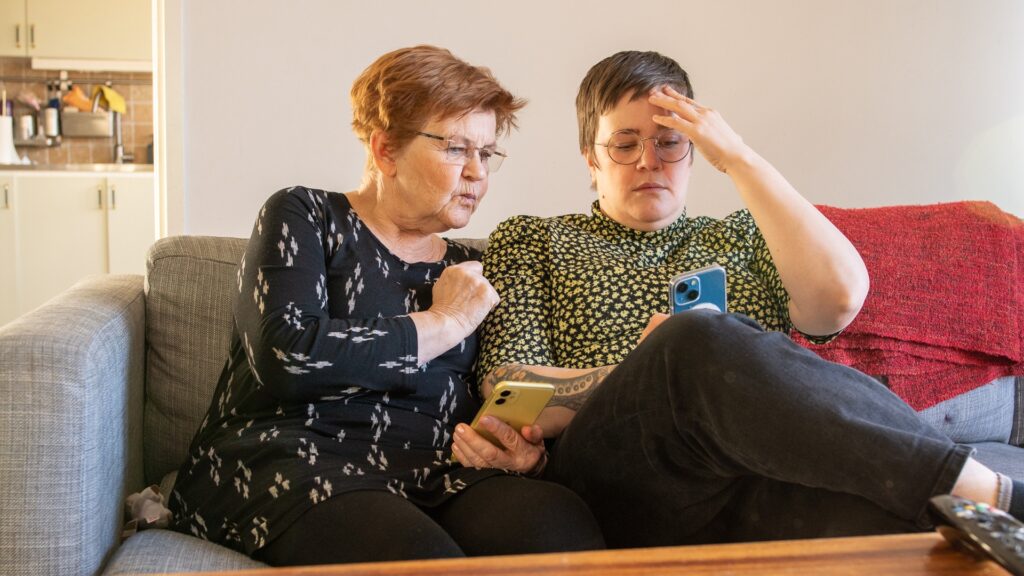Summary
English
Welcome to The Swedes and the Internet 2023, a unique survey of Swedish people's digital presence. With this report, The Swedish Internet Foundation wants to contribute facts and insights about how the Internet in Sweden is developing and to provide the preconditions for the digitalisation of Swedish society and business to take place on a well-informed foundation.
A unique insight into Swedes' digital lives
Swedes do not want online targeted advertising but think the police should be allowed to access private conversations online in cases of suspected crime. We worry about filter bubbles and online hate but celebrate digital books and believe in digitalisation's positive climate impact. This is digital Sweden in 2023.
World events affect the Internet
This year, we can see how events in the outside world also affect digital life. Most people see it as likely that a cyberattack against Sweden could knock out important infrastructure such as the Internet, electricity and water.
Since Russia invaded Ukraine, many Swedes have increased their news consumption and become more critical of sources. One in two also worry about filter bubbles – that what they see online is only a selection that reinforces their opinions.
The public debate on law enforcement is also reflected in the digital sphere. Almost all Swedes think that the police should have access to private online conversations if a crime is suspected. Most also think that camera surveillance with facial recognition in public places should be allowed.
This does not mean that digital privacy is considered unimportant. Just over half feel violated by the collection of personal data online. The majority of Swedes do not want customised advertising based on their internet use. Just over half also think it is unacceptable for an employer to Google them before possible employment.
Social media – important news channel
Social media is the most important source of news for young Swedes. Most people read the news directly in the digital feed — a few click through to a news site. Tiktok is an important source of social news, especially among young women. More than one in three Swedes also follow someone online for social news — among the most popular are politicians, such as Magdalena Andersson and Ulf Kristersson.
Unfortunately, online public discourse is also characterised by hate, harassment and a harsh discussion climate. Most often, online hate is connected to personal or political opinions. This has consequences for more than just those who are themselves affected. One in two Swedes avoid commenting and discussing things online for fear of being subjected to online hate.
At the same time, digitalisation opens doors. Readers of e-books and audiobooks highlight advantages, such as being able to take more books on a trip and being able to do other things while listening to audiobooks. In particular, many older people and people with disabilities state that they would not be able to read at all if it were not for the features of digital books.
An internet for everyone
This year, we also asked Swedes about the climate impact of digitalisation. Most people see both advantages and disadvantages but have an predominantly positive view of how the Internet and new smart technology can help us create a sustainable society.
These are just some of the many exciting areas we explore in this year's report. Feel free to read the chapter summaries for a quick overview and dive deep into how Swedes use social media, news consumption, e-services and children's digital lives.
The Swedish Internet Foundation works for an Internet that contributes positively to people and society. Our vision is that everyone in Sweden wants to, dares to and can use the Internet. With The Swedes and the Internet survey, we want to offer a fact-based foundation for how digitalisation — and society — can be further developed for the benefit of everyone.
Chapters
- Internet use and exclusion
- E-services and the digital public sector in Sweden
- Sustainability – the Internet's climate impact
- Web browsers and Wikipedia
- Attitudes to personal data and online surveillance
- Online hate and harassment
- Societal news in traditional and digital media
- Books and Podcasts
- Social media
- The children and the Internet
Note: Questions about AI were done in a separate study during August–September 2023. The results are collected on this page in Swedish.
The Swedish Internet Foundation hired the analysis and research company, Novus, for data collection during January and February 2023 for all studies. The majority of the data is collected in Study 1 (n=2 954), and Study 2 (n=3 503) in Novus' randomly recruited Sweden panel, with a participation rate of 63 per cent and 62 per cent, respectively. The results are weighted against Statistics Sweden (SCB) regarding gender, age, education and geography. Read more about the methods and sample here.
Chapter 1: Internet use and exclusion
In this chapter, we present how much of the population used the Internet compared to the previous year. We ask those who have reduced or completely stopped using the Internet about their reasoning behind this. In the wake of digital exclusion, we also take a closer look at retirees' Internet usage and learn what they wish was easier online. Likewise, people with disabilities and foreign-born citizens describe their digital challenges.
Internet usage has changed marginally in 2023
Almost everyone in Sweden uses the Internet. In 2023, the percentage of those who do not use the Internet decreased by 1.2 percentage points. Therefore, only four per cent of the population ages 16 years or older do not use the Internet. This means that the percentage of Internet users has increased by the equivalent of 1.2 percentage points to 96 per cent.

Illness and physical obstacles cause us to disconnect from the Internet
4 per cent of the population does not use the Internet and another 4 per cent is not online every day. Some were online more often in the past. Similarly, some non-users have been online before. It is almost exclusively the oldest in our society who do not use the Internet at all or are not using it daily. The main reasons for using the Internet less, or leaving it altogether, are illness or various physical obstacles.
Every seventh retiree does not use the Internet
Many retirees are as digitally savvy as the younger population. However, the proportion of non-users rises with age, and among those over 75, three out of ten do not use the Internet. Those who have never used the Internet indicate a lack of interest as the main reason.
We asked retirees who use the Internet what they would like to see made easier online so they do not have to ask for help. The most common answer is "most things" or even "everything". Above all, they would like to simplify contact with authorities and healthcare via the Internet.
People with disabilities about being hit hard by algorithms
Digital technology can be experienced as limiting or exclusionary for people with physical impairments. People with a disability or functional variation describe, among other things, difficulties with filling out e-forms on government websites, about addictive algorithms, and a desire for more online forums for those with the same diagnoses.
Foreign-born responses on the challenge of understanding the digital society
The possibility of using society's e-services may differ for those not born in Sweden. It is not just about the challenges of getting a social security number or Bank ID. Foreign-born people also describe challenges with language barriers, insecurity and difficulties in learning and understanding the structure of the Swedish digital society.
Chapter 2: E-services and the digital public sector in Sweden
In this chapter, we examine how many people use a so-called digital mailbox and which mailbox they have. We also present how many people use healthcare apps for digital medical appointments and which such apps they have used. Furthermore, we follow up on how e-identification and mobile Bank ID have developed in the past year. When it comes to e-services in general, how do Swedes think Sweden compares to other countries? And how likely do we think different types of cyber-attacks are? We also provide answers to these questions in this chapter.
Small differences in the use of e-services between the years 2022–2023
Almost everyone, as much as 93 per cent, uses e-identification, which is a slight increase compared to the previous year. It is thanks to the fact that mobile Bank-id is increasing somewhat among the elderly. Seven out of ten use digital mailboxes, which aligns with the previous year. E-services for healthcare are used by eight out of ten, which is a slight decrease, most likely connected to the fact that the COVID-19 pandemic is over.

Private actors' e-services more popular than government ones
Of the e-services we examined, most use the private actors' options, not the government's. The most popular digital mailbox is Kivra. Kry is the healthcare app used by most people. Mobilt Bank ID dominates among e-identifications. For the latter, a government alternative has yet to be introduced.
Swedes believe that we are ahead of the rest of Europe when it comes to e-services
Every fifth Swede is unaware of how Sweden stands in terms of e-services compared to our Nordic neighbors and the rest of Europe. Most believe we are ahead of Europe, but not as many believe we are ahead of the other Nordic countries. It is e-services, such as Bank ID and Swish, that make Swedes think that we are ahead of other countries. The lack of a national e-identification and the fact that we cannot vote digitally leads some to believe we are behind.
The majority of Swedes see various cyber-attacks as likely
Eight of ten Swedes believe foreign powers could obtain information critical to society in a cyber-attack. More than six in ten see it as likely that cyber-attacks could knock out the Internet or connected systems, such as heating, electricity and water. The older half of the population sees cyber threats as more likely than the younger half. Younger people, born in the 90s and 00s, see it as the least likely, especially young women.
Chapter 3: Sustainability – the Internet's climate impact
In this chapter, we find out how many believe that the Internet and the digitalisation of society have a predominantly positive or predominantly negative climate impact. We also had respondents describe in their own words which positive and negative climate effects they think digitalisation has. Furthermore, we investigate who keeps track of the household's electricity consumption with climate-smart technology, how many people (do not) recycle their discarded digital devices, and their reasons for keeping them.
More than twice as many believe that the Internet has a positive rather than a negative climate impact
One third believe that the Internet and digitalisation have a positive impact on the climate and the environment; not even half as many see a negative climate impact. Young people are the best at taking a stand on the issue. The most positive are people born in the 80s, and the most negative are those born in the 00s. Significantly more men than women are positive, and the difference is greatest between young men and women born in the 90s and 00s. Whichever way you look at it, most people see both positive and negative climate effects with digitalisation, which together form the so-called net effect.

Digitalisation preserves our forests as we reduce paper consumption
Swedes believe that the Internet has a positive climate impact because it promotes the dissemination of knowledge and research, commitment to climate issues increases, environmentalists unite, paper consumption is reduced so that the forest is preserved, traveling by car and plane is reduced with work from home and digital meetings, logistics transport in e-commerce is made more efficient so that we do not have to take the car to the store, our energy consumption is automated and reduced with smart technology, and digitalisation drives the development of fossil-free sources and much more.
Digitalisation depletes our soil of metals and minerals for the manufacture of digital devices
Swedes consider the Internet to have a negative climate impact because energy use is increased by server halls, cryptocurrencies and streaming, the fossil-free energy sources are too few, digital devices are made from metals and minerals that deplete the earth and are difficult to recycle, e-commerce encourages overconsumption with transport and free returns from all over the world, "fake news" regarding the climate spreads, polarisation is increasing and climate commitment is dampening, screen time is distancing us from nature, and many other reasons.
One fifth keep track of household electricity consumption with connected technology
One fifth of Swedes use an app or connected electricity meter to keep track of the energy consumption of various household products and the household. It is most common among those who live in villas or terraced houses. More men than women keep track of household energy consumption with digital aids.
Half do not recycle digital devices they have stopped using
A large proportion of people do not know how to recycle their digital devices in an environmentally friendly way. Half of the Swedes keep all their discarded digital devices at home in drawers instead of recycling them. The main reasons for not recycling are to keep them as a backup or that there is personal information on a device they do not want, for example, to fall into the wrong hands or even know how to delete.
Chapter 4: Web browsers and Wikipedia
In this chapter, we find out which browsers Swedes use. We also report who knows about and how many have visited the Darknet. Furthermore, we find out how many and who use three knowledge databases, namely Wikipedia, NE.se (National Encyclopaedia) and IMDB (Internet Movie Database).
Google Chrome dominates
The most commonly used web browser is Google Chrome. The younger half of the population has Apple's Safari browser as their second choice, and the older half has Microsoft's browser. Google Chrome, as the first choice, is challenged most among young women by Safari. Mozilla Firefox is only used by a few and mainly by men.

Young men have the most insight into the Darknet
Although only two per cent state that they have visited the Darknet in the past year, two out of three Swedes know about this hidden part of the web. Awareness of the Darknet is significantly greater among men than women. Men born in the 90s and 00s have the greatest insight into the Darknet, with nine out of ten stating that they know about the Darknet and one out of ten that they have visited the Darknet in the last year.
Three times more people use Wikipedia than NE.se
One fifth have used the encyclopaedia NE.se - Nationalencyklopedin in the past year, and three quarters have used Wikipedia. Therefore, more than three times more people have used Wikipedia than NE.se. More women use NE.se, and more men use Wikipedia. Among children and adolescents, one third have used NE.se and two thirds Wikipedia. The difference between how many children use NE.se and Wikipedia is thus still large, but considerably smaller than in the general population.
Seven per cent do not trust the content on Wikipedia at all
Confidence in the content on Wikipedia is high – at least to some extent. Four out of five trust that the content on Wikipedia is at least partly true, but it is only slightly more than one out of five who trust that the content is mainly true. Seven per cent do not trust the content on Wikipedia at all. The most sceptical are women born in the 70s and 80s. Only two per cent have contributed their own material to Wikipedia in the past year, the majority of whom are young men.
Every third Swede uses the film database IMDB
IMDB - Internet Movie Database - is used by every third Swede. More men than women have used IMDB, which is most popular among those born in the 90s. Three out of four men born in the 90s have used IMDB, which is the most of anyone. Among children and adolescents, the use of IMDB only takes off in upper secondary school, probably because IMDB is an English-language database.
Chapter 5: Attitudes to personal data and online surveillance
In this chapter, we ask Swedes who use the Internet to consider different attitudes connected to personal data online. Do we feel violated, or do we not care if someone collects it? How do we feel about personalised advertising or a potential employer Googling us? Is law-enforcement more important than caring about citizens' online privacy? We provide answers to these and other questions.
Just over half felt violated by the online collection of personal data
There are slightly more people who feel violated than those who do not care that their personal data from their Internet usage is being collected. The people who care the least are those born in the 80s, and those who care the most are those born in the 90s. Young men born in the 90s and 00s feel the most violated. Overall, more men are thinking about the consequences they may suffer linked to their personal data online.

However, most Swedes believe that even those with nothing to hide need to consider what personal data their Internet use generates. Since the outbreak of war in Ukraine, some have changed their online behaviour with this in mind. Several say they read the news more critically and have reduced or completely stopped using social media. They also think more about what they "like", post and share.
Older people do not think targeted advertising is ok
The majority of Swedes do not want customised advertising based on the personal data generated by their Internet use. The older half of the population is the most negative; the older the more negative in ascending order. Young women are the most positive about targeted advertising.
Adolescents do not want potential employers to Google them
Just over half of Swedes do not consider it okay for an employer to look at their public Internet information and social media before hiring. Those who are most sceptical are the adolescents, mainly students. Compared to white-collar workers, blue-collar workers are also significantly more negative about being Googled before employment.
Most are positive to law enforcement camera surveillance
Most people want camera surveillance with facial recognition to be allowed in public places to facilitate law enforcement. Significantly fewer, only two out of ten, believe it should be prohibited to protect citizens' privacy. Adolescents want it to be prohibited to a much greater degree than older people, especially young men.
Green light for the police to access private conversations online
Almost everyone – 94 per cent – believe that the police should have the right to access private conversations online if they suspect a crime, of which about half believe that it should only concern serious crimes. Only four per cent believe protecting citizens' personal integrity is more important. Young men are overrepresented in terms of the belief that it should only be allowed for serious crimes and in considering that it is more important to protect personal integrity.
Young men feel that their online privacy is being violated
Young men's attitudes to personal data online differ on several issues from the general population. More young men feel violated if someone collects personal data that their Internet use generates, and more think about the consequences for them personally. Furthermore, more young men believe it is more important to protect privacy than to let the police take crime prevention measures. Overall, this shows that young men are more concerned about their online privacy.
Chapter 6: Online hate and harassment
In this chapter, we examine how many Swedes aged 16 or older have been subjected to online hate speech, harassment, or negative comments or who have seen others subjected to it. We show who is more vulnerable than others and what the harassment is about. Furthermore, we find out on which social media platforms online hate speech and harassment occur. We also highlight how common it is to avoid posting posts or comments for fear of online hate.
One in twenty has been subjected to online hate in 2023
Just over one in twenty of the population aged 16 or older state that they have been subjected to online hate speech, harassment or negative comments online in the past year. The proportion of those subjected has not changed significantly compared to the previous year. Men are affected to a greater extent than women, and adolescents to a greater extent than older adults. Four out of ten have seen others subjected to online hate speech or harassment online – women to a greater extent than men.

Most of the online hate speech is about political or personal opinions
Personal or political opinions are the most common reasons for being targeted for online hate speech or harassment – both based on what the person has been subjected to themselves and what they have seen others subjected to. Among Swedes aged 16 or older, three per cent have been targeted by online hate speech or harassment linked to political and/or personal opinions in the past year. This corresponds to approximately half of those who have been targeted.
Half refrain from commenting on posts for fear of online hate speech
Online hate not only affects those who are personally subjected, but also others. For example, more than half of all people aged 16 and over avoid commenting on posts, news articles or sharing their opinions in their posts on social media due to fear of online hate speech, harassment and negative comments. More women than men avoid posting posts or comments.
Online hate is most prevalent on Facebook, Instagram and Twitter
Online hate and harassment occur to varying degrees and in different ways on different social networking platforms. The amount of users on a platform greatly influences how many are at risk of being affected by online hate or harassment. Many are, therefore, affected by large platforms such as Facebook and Instagram.
However, some platforms stand out more than others. Twitter (which changed its name to X in July 2023) seems to be more affected than expected based on how many people use the platform. This may be because Twitter is a platform heavily used to express political and personal opinions – the most common cause of online hate speech and harassment. On the other hand, Youtube shows the opposite – a relatively low percentage of online hate speech and harassment, given how many people frequently use the platform.
Snapchat stands out in a different way – comparatively few have noticed that others have been subjected to online hate speech or harassment on Snapchat. This is despite the fact that the proportion of those affected is comparable to Twitter and Instagram. This may indicate that online hate and abuse on Snapchat takes place to a greater extent in private, without the view of outsiders, compared to other platforms.
Chapter 7: Societal news in traditional and digital media
In this chapter, we find out how many people participate in societal news and which media channels they choose. We also investigate how many Swedes "follow" someone to get societal news and which people they follow. In free text, we let the respondents tell us which channels they (more or less) trust. Furthermore, we take a look at whether there is concern about so-called filter bubbles – both for themselves and others. We also investigate whether the war in Ukraine has affected Swedes' news consumption in any way.
Almost all Swedes consume societal news
The line between digital and traditional media is blurred as traditional media, such as television, radio, and newspapers, can often be consumed online. News apps, websites and news pages on social media are also making the distinction between the various channels less and less clear. The range of news channels is greater than ever thanks to today's technology, and almost everyone, 94 per cent of Swedes, takes part in societal news. News consumption is somewhat lower among those born in the 00s, and men born in the 00s lag behind women of the same age when consuming societal news.
TV channels have the top position among news sources
Swedish people primarily consume the news via television channels. This is followed by news apps and websites for societal news where the following are at the top: SVT/Sveriges Radio, Aftonbladet and Dagens Nyheter. Radio channels take third place, and in fourth place is social media, which nearly half of Swedes use to get social news. Only in fifth place come printed newspapers, primarily read by those who do not use the Internet.

More adolescents consume news in social media than in traditional media
Channel choice for societal news differs significantly between those born in the 20th and 21st centuries. Those born after the turn of the millennium do not have television channels in the first place like the population at large. Instead, they mainly take part in societal news on social media. They also use traditional media significantly less than those born in the 20th century. Overall, social media is the only news source that more people born in the 21st century use than those born in the 20th century.
Tiktok – major news channel among adolescent women
Facebook is the social media service on which the majority of Swedes consume societal news, followed by Instagram, Youtube and Twitter. However, this does not apply to those born in the 21st century who mainly take part in societal news on Tiktok. More than one in four born in the 00s, and up to half of the women born in the 00s, use Tiktok as a news source. The contrast is significant between those born in the 20th century, where only one per cent use Tiktok for societal news.
News on social media is mainly consumed in the "feed"
More people take part in societal news directly in their feeds on social media than actively access various news pages or accounts on social media platforms. Men who access news on social media are more likely than women to actively access news pages from social media. Overall, men consume news on more social media services than women. Among men, Youtube and Facebook are at the top, but they also use Twitter, Reddit and Flashback for societal news to a greater extent than women. For women, Facebook and Instagram are the dominant social media services for news consumption, followed by Tiktok.
Magdalena Andersson is the most popular to follow for societal news
More than one in three Swedes follow someone in digital media online to get societal news. Magdalena Andersson, Ulf Kristersson, Ebba Busch, and Marcus Oscarsson are the most popular people to follow for societal news. Magdalena Andersson is at the top of the women's top ten, while Ulf Kristersson tops the men's. Men's and women's leader boards differ quite a bit. For example, Greta Thunberg and Annie Lööf are more popular among women, while the writer Lars Wilderäng/Cornucopia and the social commentator Henrik Jönsson are more popular among men. US President Joe Biden and Ukrainian President Volodymyr Zelenskyy are in their highest positions on the top ten list for retirees regarding who they follow for social news.
Swedes say they trust SVT as a news source
The news source that most Swedes specifically mention that they trust is SVT, Sveriges Television. This applies to both young and old. However, significantly more women than men express that they trust SVT more. Other channels that many Swedes explicitly mention that they trust more are Sveriges Radio, Dagens Nyheter and TV4. More younger people express their trust in Aftonbladet, the source that most Swedes concretely state that they trust less, followed by Facebook, Expressen and the web forum Flashback.
Children and adolescents consume news via TV channels and Tiktok
Three out of four children and adolescents aged 8–19 consume societal news. The primary source among adolescents is social media, followed by television channels. The social media service where most children access news is Tiktok, followed by Youtube. These two are also the news sources that adolescents concretely say they trust less. The news channel that adolescents say they trust the most is SVT. More than one in three children follow someone for societal news, and the most popular among them is Therese Lindgren.
Half of Swedes worry about filter bubbles
Every second Swede is concerned about so-called filter bubbles. Significantly more people worry about others ending up in filter bubbles than about being affected themselves. Among those born in the 90s, awareness of filter bubbles is the highest, and those born in the 90s are the most concerned about filter bubbles, both for others and for themselves. More women than men are worried about filter bubbles, and significantly more women born in the 00s are worried compared to men of the same age.
Men use new news sources after Russia invaded Ukraine
More than half of Swedes state that the war in Ukraine has affected their news consumption. Every third Swede has increased their news consumption, and every fourth Swede has become more critical of sources after the war in Ukraine broke out. More than twice as many men as women have started using new news sources, such as the BBC, CNN, Lars Wilderäng/Cornucopia and various accounts on X (Twitter). A smaller proportion also stated that they stopped using certain news sources or generally reduced their news consumption, as the news itself affected their mood negatively and gave rise to worry and anxiety.
Chapter 8: Books and Podcasts
In this chapter, we investigate how many people have (or have not) consumed books in 2023. We find out whether the consumption of paperback books, audiobooks and e-books has increased or decreased. In addition, we let book consumers indicate which book format is their favourite and how often they borrow the various book formats from the library. The digital listeners and readers describe in their own words the advantages and disadvantages of audiobooks and ebooks – and how these digital book formats have affected their overall book consumption. Last but not least, we find out how many people listen to podcasts, and which are the Swedes' favourite podcasts.
Young men read the least of all
By 2023, two-thirds of the Internet-using population aged eight or older will have consumed books. Two-fifths read or listen to books weekly, and one in four every day. This means that a third have yet to listen to or read books at all. Those born in the 00s read the least of all, especially men, nearly half of whom have not consumed books in any format. People born in the 70s, 80s and 90s are the greatest consumers of books. Women of all ages read and listen to books to a greater extent than men.
More people read paperback books than digital books
Just over half read printed books in paperback format; a third consume digital books. Digital books include both audiobooks, which just over a quarter have listened to, and e-books, which one in eight have read. Twice as many people listen to audiobooks as those who read e-books. Those born in the 10s are at the top when it comes to listening to audiobooks. For reading e-books, those born in the 90s take the top spot.
The consumption of digital books increases
Compared to 2021, total book consumption has neither increased nor decreased. On the other hand, slightly more people listen to or read digital books, i.e. audiobooks and e-books, which are usually used as a supplement to printed paperback books. E-books are steadily increasing, both among men and women. For audiobooks, weekly consumption is increasing the most, especially among women.

Paperback books are more popular than audio books and e-books
Printed books in paperback format are the favourite among men and women of all ages. As many as seven out of ten who consumed books in 2023 have paperback books as their favourite. Paperback books are described as having "more soul" than digital books, including the "smell of paper" and the symbolic value of a bookshelf "full of memories" in the home.
However, the paperback book is losing popularity among audiobook listeners, and the audiobook is rising as a favourite. The audiobook is the most popular among those born in the 80s and 00s, and the paperback book is also the least popular. The paperback book is most popular among those born in the 90s and the very oldest, who are not as fond of audiobooks.
Paperback books decrease and e-books increase among those born in the 90s
Although those born in the 90s are one of the biggest book consumers and prefer paperback books to a higher degree than others, they have slightly reduced their consumption of paperback books in 2023. Instead, they are increasing their consumption of e-books. E-books are most popular among men born in the 90s and 80s. The e-book is also the only book format preferred by more men than women.
Four out of ten children have not read or listened to a book in 2023
Among children and adolescents aged 8–19, just over six of ten read or listened to books in 2023. Close to four out of ten children have not consumed books in any format, which is slightly more than the population at large. Book consumption is highest among primary and middle school children, then decreases among secondary school children, and then increases again among adolescents in upper secondary school.
Secondary school children are those who read the least, where more than four out of ten have not consumed books in 2023. The paperback book is also a favourite among children and adolescents. The paperback book is the least popular among secondary school children, and the audiobook is the most popular. Those in upper secondary school have increased their book consumption slightly since 2021, while the total book consumption for children and adolescents is unchanged.
More people borrow ebooks than audio books from libraries
Although more people consume audiobooks than e-books, more people borrow e-books from the library. However, the paperback book is the most popular format to borrow. In 2023, three out of ten Internet users have borrowed a book in some format from a library, and the youngest are the most active in borrowing books. Close to six out of ten children in primary and middle school have borrowed books, and almost all have borrowed paperback books.
Digital books are considered easy to travel with and good for the climate
The greatest benefits that digital book consumers see with audiobooks and e-books are that they are easy to carry and travel with, are more environmentally friendly than paperback books and are available in a large, easily accessible and cost-effective range. People with visual impairments also find that digital books facilitate their book consumption. Disadvantages of digital books are that the digital device you listen to or read your book on often disrupts the book experience with notices or notifications, that the device requires batteries that can run out, and that if you subscribe to a book service, you do not own the books.
Audiobooks allow you the opportunity to catch up on more books
One of the unique advantages of the audiobook as a book format is that you can do other things at the same time. The consumer can have their hands free and multitask, thus catching up on more books. Audiobooks can also be listened to together with others, relax to, and use when going to sleep. People with ADHD or dyslexia also find that audiobooks facilitate their book consumption. The downside of doing other things while listening is that you can become distracted while listening to the book, lose focus and have difficulty finding your way back. Some also do not feel that they remember what they read or do not immerse themselves in the story as much when they "read with their ears". Listening alone also raises concerns about "losing reading skills" and an "vocabulary erosion".
E-books allow you to enlarge the text so that you do not need reading glasses
The e-book's unique advantages as a book format include the ability to enlarge the text, adjust the brightness and read in both darkness and bright sunlight, and easily search the text or for your own comments. Reading e-books on a reading tablet specifically designed for book reading offers additional advantages, such as its e-ink (display technology E-ink), which is good for the eyes and gives the "same feeling" as a paperback book, and that it does not contain any other apps that give "disturbing notifications".
Disadvantages of the e-book differ if you read the ebook on a tablet or another digital device, such as a mobile phone, tablet, or computer. The screens of the other digital devices are considered to have a glare, are poorly lit and are the wrong size. Reading books on these can cause both headaches and eye pain. In addition, many feel that they already spend so much time on these devices that they do not want even more screen time. Regarding e-reading tablets, many believe that "the e-reading tablet market is a jungle" and experience "compatibility problems" between their e-reading tablet and the various book streaming services.
Swedes' favourite podcast is P3 Dokumentär
Half of Swedes have listened to a podcast in the past year. Podcast listening is increasing in 2023 among both men and women, and also on a weekly and daily basis. Those born in the 90s listen to podcasts the most, but the increase is greatest among those born in the 80s. The most popular podcast is P3 Dokumentär. In second place comes the podcast Flashback Forever and then Creepypodden.
Children and adolescents' favourite podcast is Vad? (IJustWantToBeCool)
More than one in three children aged 8–19 listen to podcasts. Podcasts become more popular as children age, and podcast listening among children has increased in 2023. Among children and adolescents, the podcast Vad? (IJustWantToBeCool) is the favourite among both boys and girls. In second place comes the podcast Frågar åt en kompis, and in third place the podcast Ursäkta.
Chapter 9: Social media
In this chapter, we show how many people use social media, which services are used and whether they have increased or decreased compared to the previous year. We also find out which are the most popular, i.e. which social networking platform is the favourite if only able to choose one. Furthermore, we examine the driving forces that make us use social media and whether the motives differ for the different services. Last but not least, we find out who does not use social media and why.
In the summer of 2023, Twitter rebranded to X. Data collection and analysis for this study was done before the name change, consequently the name Twitter is used in this report.
Tiktok is the fastest growing of all social media platforms in 2023
Compared to 2022, more social media platforms are growing in 2023. Tiktok accounts for the largest increase in the share of users, from 20 per cent to 24 per cent in 2023. Twitter, Roblox, Reddit and Flashback are also increasing. The growth is mainly occurring among people born in the 90s or 00s, except for Roblox, which is increasing most among those born in the 10s. One social media service is also losing users, and that is Facebook. It is mainly those born in the 60s and 80s who have stopped using Facebook, which has decreased from 71 per cent in 2022 to 68 per cent in 2023.
Those born in the 20th and 21st centuries have different social media as their top three
The population's three most used social media platforms are Youtube, Facebook and Instagram. However, a clear dividing line is surfacing between those born in the 20th and 21st centuries regarding which social media are used and to what extent. Among those born in the 21st century, Facebook and Instagram are no longer at the top. After Youtube, Snapchat, Tiktok and Roblox instead qualify for the top positions among those born in the 00s and 10s.

Twitter is used by more than half of all men born in the 90s
Linkedin, Flashback and Twitter do not qualify as the three most used social media in any age group. However, they compete for fourth and fifth place among the generations of the 20th century. Linkedin is used by well over half of all white-collar workers and mainly among people born in the 70s, 80s and 90s. Flashback reaches its top position among those born in the 80s. Twitter is used most by men born in the 90s, more than half of whom will have used Twitter in 2023. Among those born in the 00s, Be Real is up and coming. Be Real is used by six per cent of the population, especially by women. Among women born in the 00s, 44 per cent have used Be Real in 2023.
Facebook is the favourite among retirees
If Swedish people can only choose one social media platform, Youtube is the favourite. In joint second place comes Facebook and Instagram. Among those born in the 20th century, Facebook is the most popular, followed by Instagram and Youtube. The favourite of those born in the 21st century is Youtube, followed by Snapchat and Tiktok. Among those born in the 00s, Snapchat is slightly more popular than Youtube. Men have Youtube as their favourite, and Instagram is the favourite among women. Facebook is in second place with both men and women, although it is the most popular among retirees.
The biggest driving force for using social media is to be amused
The main drivers for using social media are to be entertained by funny clips and to pass the time. Next, people use social media as a digital contact list of friends and keep track of what friends and acquaintances are doing. Accessing societal information and congratulating friends on their birthdays ranks higher among retirees. More women than men are motivated to use social media as a digital photo album or a diary to preserve memories. Those driven by being able to express their opinions and make their voice heard usually have Twitter as their favourite.
Adolescents use social media to keep up with friends
Every fifth Swede is motivated to use social media to socialise with others, especially those born in the 21st century, half of whom use social media to socialise with friends. Those born in the 00s mainly hang out with friends on Snapchat, and those born in the 10s on Roblox. Only about one in ten born in the 20th century is motivated to use social media for socialising, and they socialise primarily on Facebook and Instagram. Of all the social media, Snapchat is the service that most Swedes socialise on.
Facebook and Instagram are declining among upper secondary school children
Youtube is the service that children and adolescents use the most, regardless of school age. Primary school children mainly use five social media platforms: Youtube, Roblox, Tiktok, Snapchat, and Instagram. Roblox reaches its peak with 68 per cent of users among primary school children. Middle school children even start using Twitch and Pinterest. At secondary school age, all social media are used, except Linkedin, which first begins to be used by upper secondary school children. Tiktok gets its top listing with 81 per cent of users among upper secondary school children. Fewer upper secondary school children use Facebook and Instagram in 2023 compared to the previous year.
Six per cent of Internet users do not use social media
Almost everyone who uses the Internet also uses social media. There is, however, six per cent of the Internet-using population who do not use any social media at all, and these are mainly retirees. The reasons are many and varied. For example, social media platforms are perceived to be uninteresting, too time-consuming, too technically complicated, too privacy-infringing, too antisocial, too commercial, too risky, and too addictive. Some also think that social media is simply "nonsense".
Chapter 10: The children and the Internet
In this chapter, we examine different parts of the digital life of children aged 8–19 from both the children's and parents' perspectives. How many children play VR and other digital games – and how many hang out digitally with friends in computer games? When do children get their own mobile phone to call and surf on – and how well does it match when parents think children should get their first mobile phone? We also continue to monitor how many children aged 12–19 have been exposed to online hate or negative comments. New for this year is also to investigate how many children ages 12–19 have had nudes (in other words, nude pictures) sent to them, or who themselves have sent nudes to others, as well as how many have been a victim of image-based abuse in so-called expose accounts.
Note! For this chapter, we would like to clarify, purely methodologically, that if the responding parent has several children in the age range of 8–19 years old, the parent only has to answer for one randomly chosen child. Children under the age of 16 have, in turn, been interviewed given their guardian's approval. For more information, see the Method Description in Swedish.
In practicality, all children from the age of eight use the Internet
Internet use among children aged 8–19 has been very high for several years and will continue to be so in 2023. Already in primary school, almost all children use the Internet (97%), and nine out of ten primary school children do so daily. All children in middle, secondary and upper secondary school basically use the Internet every day.

Parents give mobile phones to children before what they think is the "optimal age"
On average, parents think it is appropriate for children to get their own mobile phone for surfing and making phone calls at the age of ten. Despite that, the majority of children state that they got their first mobile phone before they turned ten, and already in primary school, seven out of ten children state that they have their own mobile phone.
It is common for parents to follow their children using location data in the mobile phone
The mobile phone not only fulfills an entertainment value for the children but also provides an opportunity for parents to keep track of where the children are. More than half of all parents of children aged 8–19 can see their child's location through location data on the child's mobile phone. Parents usually ask their children for permission to access the child's location data – but a sixth of all parents track their child's location without asking for permission. It is particularly common for parents to track their younger children in elementary or middle school without asking for the child's consent.
The percentage of children affected by online hate continues to be high
The percentage of children aged 12–19 exposed to online hate speech or negative comments almost doubled between 2021 and 2022 (from 9% to 17%). Unfortunately, the proportion is still high – in the 2023 survey, 15 per cent stated that they had been subjected to online hate speech or that someone had written negative comments about them.
Girls are particularly exposed to nudes
Almost one in eight children aged 12–19 have had nudes (naked pictures) sent to them by someone they do not know. It is particularly common among girls, where nearly every sixth girl has experienced it in the past year. Almost one in ten girls (8%) aged 12–19 have also been asked to send nudes of themselves for payment, something only two per cent of boys have experienced.
There are generally few who have been affected by having their nudes posted on so-called "expose accounts" – here, however, the reverse applies. During the year, a slightly larger proportion of boys (2%) aged 12–19 experienced this compared to girls of the same age (0%). Just as many boys as girls confirm that they have had someone write crappy things about them in "expose accounts" in the past year.
Parents do not know if the kids send nudes of themselves
When adolescents send nudes of themselves, they usually do it to someone they know or are involved with. Five per cent of children aged 12–19 confirm that they have sent nudes during the year to someone they know or are involved with, and among upper secondary school children, almost one in ten (8%) have done so. Comparatively few have sent nudes of themselves during the year that they later regretted. At the same time, there may be consequences at a later stage, which may be difficult for the child to predict. Parents are largely completely unaware of whether their children have sent nudes of themselves or not, which may indicate a need for more dialogue around these issues.
The vast majority of children play computer games
Nine out of ten children aged 8–19 play various computer games on connected devices. Almost as many girls as boys play, but the boys have tested VR games to a greater extent and hang out with their friends on different game platforms to a greater extent.
